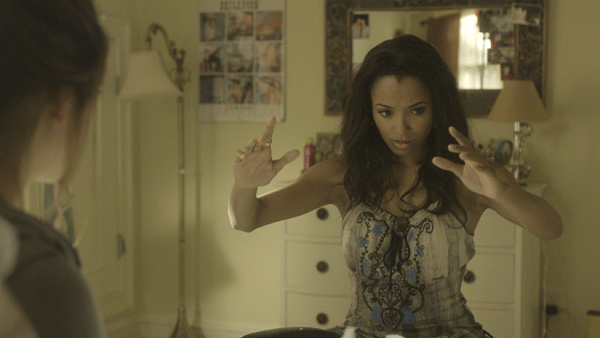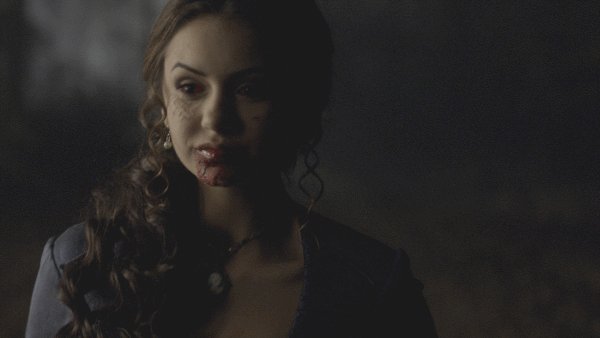Mat Beck of Entity FX tells us about the making of the People's Choice Award winner for Favorite New Drama.
The Vampire Diaries, which debuted last fall, and airs Thursdays at 8/7 Central on The CW Network, is about a high school girl torn between two vampire brothers. All the vfx is done by Entity FX (with Brian Harding serving as visual effects supervisor) and features a variety of work, including signature vampire "eye" effects to express angry or hungry vamps; "speed effects"; and even a witch that shows off her powers by levitating a room full of feathers. We spoke with Mat Beck, senior visual effects supervisor.

The signature effect involves bulging veins to differentiate vampires and express certain emotions. All images © Warner Bros. Television/The CW Television Network and courtesy of Entity FX.
Bill Desowitz: Let's begin with the signature "eye" effects, especially the bulging and pulsing veins on their faces that are the hallmark of the vampires.
Mat Beck: It's digital makeup with a personality because it moves and changes constantly. It's interesting because early in the show there was a bit more happening within the actual eye itself but as we've progressed, this shot has evolved and we've developed the ability to convey quite a bit with the veins around the cheek bone and under the eye. And the challenge and opportunity, of course, is to tie it in to the actual performance. It shows emotion, it shows rage, it shows arousal, it shows ambivalence, it shows conflict. In order to be able to modulate the performance, each character has his or her own set of veins that are adjusted for their personality and physiognomy. And the individual veins can be controlled for color or height rising out of the skin and highlights and shadow and movement of blood through them. And individual veins can be rising while others are falling.
We've written some custom software that makes it easier to tweak all these variables to play along with the actor's performance to set the tone that the show's creatives want for each moment. Of course, the other thing is you have to make this surreal moment look convincingly physically real. So the veins have to look like they are actually under the skin of the actor. To do that we have a variety of 3D and 2.5D techniques that, in effect, model the skin over the bone so that as the skin of the real actor deforms, the pattern of veins deform with it. It's more than just a simple tracking mark here or there: We actually had to have tracked the deformation of the whole patch of skin under each eye.
BD: What software do you use for this?
MB: Besides some internally-generated scripts, we use Maya for the 3D and then, depending on the shot, the compositing work is done with After Effects or Discreet boxes.
BD: Tell us more about your custom software.
MB: What we did was generate 3D mapping of the skin so whatever you do to the vein is automatically tracked onto the surface. So whatever tweaks are done to the veins are automatically run through a module that customizes it to the facial movements of the actor. This allows us to respond quickly to any notes and get a few more iterations in a tight time frame. Some of the best moments are more subtle, like when the effect is just coming on or just dissipating. There's one scene where a character is getting aroused but is conflicted about it so we were able to convey this through the movement of the veins growing and shrinking as he was trying to suppress his arousal a bit.
BD: What are some of the power effects?
MB: Vampires can move really quickly and travel through the air pretty quickly, so there's a lot of super fast running and stunt work, which sometimes involves wire removal or rig removal or deforming the body when withstanding impact from vehicles or from fighting with each other. Sometimes we will just roto the vampires and fly them digitally. We also add a lot of blood in spots. One of the advantages of not doing blood on set is you can adjust it later on to set the right tone. We've tracked blood onto mouths of vampires who have just been feeding; we tracked wounds onto their victims; pools of blood on the floor when someone has just landed. Killing vampires with a stake involves a lot of discoloration and a wide area of grossly bulging veins tracked all over neck and face.

The trick of the levitating feathers was to "display sensitivity to little wind movements and to have the fine fibers react to the light."
BD: What about Bonnie (Katerina Graham) revealing her abilities by levitating a room full of feathers?
MB: It was fun because a lot of the show is dark for obvious reasons and part of the fun of the feathers is we wanted to make it graceful and also beautiful. So not only is it putting CG feathers into the room and lighting them well but also making them move in a way that was fun to look at, and it's also tied to her performance because she controls them through her movements. And there are some practical feathers and we had to match those, of course. But the ones flying in the air in formation are CG, and those were fun to do. We've done feathers before and we have that down. The trick is to have them display sensitivity to little wind movements and to have the fine fibers react to the light. When you get those two things, you're pretty far along.
BD: And what about the environments?
MB: We've extended the environment with matte painting and also have made it more creepy with digital fog or scary by adding fire. We've also added in the odd CG raven as needed.
BD: What about the matte paintings?
MB: An example is a distant waterfall in a view from a bridge: the usual stuff where you expand the world of the story.
BD: How about a sneak peek of what's upcoming?
MB: Well, I can't give away the store too much, but there are some new characters being introduced that should give us more opportunities to mix VFX and performance and add to the impact of the show. Sometimes we can even help the creatives alter the meaning of a scene by adding an effect in post. It's all part of the power of the modern world of digital effects. And it all has to happen quickly because it's TV, but it has to be great because it's The Vampire Diaries.
Bill Desowitz is senior editor of AWN & VFXWorld.








